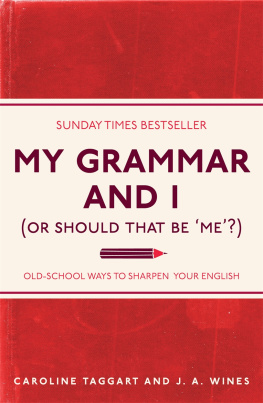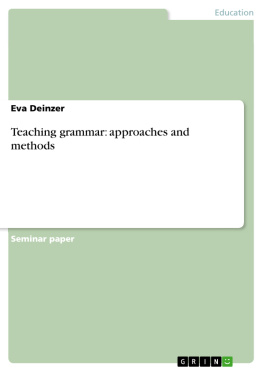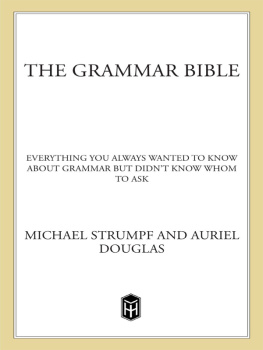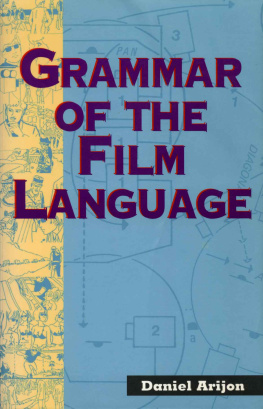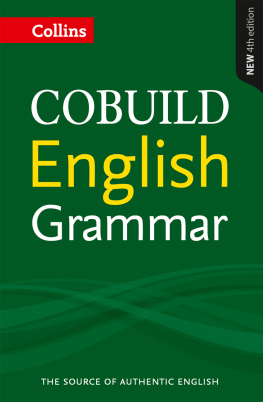GRAMMAR WARS
Dedicated to Lawrence D. Green
Grammar Wars
Language as cultural battlefield in 17th and 18th century England
LINDA C. MITCHELL
San Jos State University, USA
First published 2001 by Ashgate Publishing
Reissued 2018 by Routledge
2 Park Square, Milton Park, Abingdon, Oxon OX14 4RN
711 Third Avenue, New York, NY 10017, USA
Routledge is an imprint of the Taylor & Francis Group, an informa business
Copyright Linda C. Mitchell 2001
All rights reserved. No part of this book may be reprinted or reproduced or utilised in any form or by any electronic, mechanical, or other means, now known or hereafter invented, including photocopying and recording, or in any information storage or retrieval system, without permission in writing from the publishers.
Notice:
Product or corporate names may be trademarks or registered trademarks, and are used only for identification and explanation without intent to infringe.
Publishers Note
The publisher has gone to great lengths to ensure the quality of this reprint but points out that some imperfections in the original copies may be apparent.
Disclaimer
The publisher has made every effort to trace copyright holders and welcomes correspondence from those they have been unable to contact.
A Library of Congress record exists under LC control number: 2001046420
ISBN 13: 978-1-138-70209-7 (hbk)
ISBN 13: 978-1-315-20984-5 (ebk)
Contents
I am indebted to my family and friends for supporting me while I wrote this book, especially to Christopher Mitchell, John Jason Mitchell, John P. Mitchell, Carrie Campion, E. J. Smith, Judith A. Sipple, Mary Antoinette Smith, B. Kaye Watson, and Carol Poster. I am also grateful to the students who encouraged me during the writing process, especially Rigoberto Palacios, Abir Ward Richani, and Erma Jackson. Thanks also for support received from the faculties and staffs of Pepperdine University, University of Southern California, and San Jos State University. Most of all, I wish to thank my friend and fellow scholar Jameela Lares for her valuable advice, daily support, and endless patience.
I owe many thanks to those who guided me through the original dissertation and its subsequent revision into this book: John Bidwell, Thomas M. Conley, Walter Fisher, Thomas Gustafson, Stanley R. Hauer, James J. Murphy, John M. Steadman, and Paul M. Zall. Special thanks to Joseph A. Dane who served ex officio on the dissertation committee and to Dagmar Capkov (Charles University, Prague) for being my mentor and friend. Victoria May gave generously of her talents in graphics and design, and she worked closely with both Ashgate Publishing and rare book libraries. Leo P. Fishman made valuable final corrections on the typescript. Several assistants helped me through the most rigorous stages of the book. Christine Peek eliminated many residual errors in the formatted copy. Andrea Cruz was a matchless detective in her bibliographic work. E. D. Sweeney Schragg believed in the book, read drafts tirelessly, and made insightful directions; his energy was contagious. Thanks also to Erika Gaffney, editor, at Ashgate Publishing, for her support and advice. All residual errors are mine.
I could not have done this project without the help of Suzanne Tatian, Bruce Whiteman and the staff of the William Andrews Clark Memorial Library (Los Angeles), and of Virginia Renner, Romaine Ahlstrom, and the Readers Services of the Henry E. Huntington Library. I wish to thank those who made arrangements for illustrations: AnnaLee Pauls, Charles Greene and Ben Primer, Princeton University; Jennifer Schaffner, William Andrews Clark Memorial Library; Jamie Jamison, UCLA Library; and the Library of Congress. Graham Parry, University of York, kindly gave permission to use a privately owned illustration for the book jacket. Thanks also to the friendly and helpful rare book staffs of the Bancroft Library (Berkeley), Bibliothque Nationale (Paris), British Library, Bodleian Library, Cambridge University Library, Charles University Library (Prague), John Rylands Library, Lily Library (Indiana University), New York Public Library, Newberry Library, Scottish National Library, Stanford Library, Trinity College Library (Dublin), University of Notre Dame Library, University of Sheffield Library, Vrije Universiteit Library (Amsterdam) and University of York Library. I benefited from funding from University of Southern California and Pepperdine University. I am also grateful to Paul Douglass, chair of the Department of English at San Jos State University, for his continual support and kindness. In particular, I want to thank Dean Carmen Sigler and Associate Dean Lucius Eastman in the College of the Humanities and The Arts for the grants and travel funds that made it possible for me to complete this project.
My deepest appreciation goes to Lawrence D. Green who has served as a model scholar, teacher, mentor, and friend. Professor Green served as my faculty adviser at USC, chaired my dissertation committee, invested many hours as my mentor, involved me in research projects in primary materials, and encouraged me to present papers at national and international conferences. Without him, this book would never have been written.
Grammar is a natural battlefield for the intellect. It represents common mental ground, one of the few intellectual competencies that each of us attains. A linguistically static culture may take grammar for granted. In times of linguistic change or innovation, however, grammar becomes a hotly contested issue. Thus, during the seventeenth and eighteenth centuries, we find not only marked linguistic change but also numerous conflicts over what is called grammar. The language theorists of this period claimed they were fighting battles to correct errors in grammar and to preserve language from corruption. More significantly, however, these combatants were choosing grammar as a place to contest issues that went far beyond grammar.
The diversity of subject, organization, and formats in seventeenth- and eighteenth-century materials cannot be understood in terms of a specified number of examples. Grammar books start to make sense only when we view them as argumentative statements in controversies of the time. Grammar texts functioned as cultural statements because of the diversity of material and approaches. The terms grammar and grammar texts were ambiguous concepts that fueled the controversies over grammar. In order for twentieth-century researchers to discuss seventeenth- and eighteenth-century grammar texts, they have to define grammar. In these centuries-old texts, grammar can mean anything from parts of speech to spelling and punctuation. In order to investigate what grammar meant to seventeenth- and eighteenth-century grammarians, scholars must examine the prefaces and introductions to grammar books where grammarians carried on disputes with fellow grammarians and linguists about such topics as religion, politics, linguistics, women, foreigners, social status, and even science. Without those treatises, we would not know as much about how grammar was conceived during this period.
I. Riotous Definitions of Grammar and Grammar Texts
Previous scholarly definitions of what grammar meant to the writers of these texts have failed to account for their riotous diversity, primarily because such definitions have stated our modern concerns rather than those of the period. I will instead try to make sense out of the diversity of grammar texts by examining their changing definitions of grammar. According to Ian Michael in



